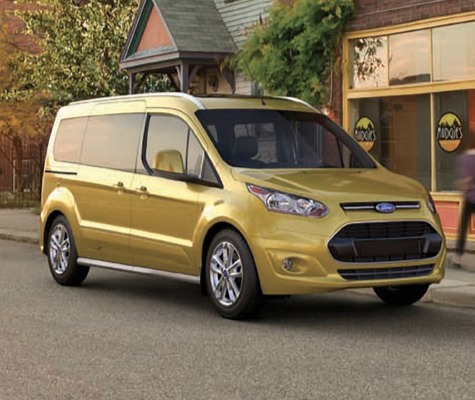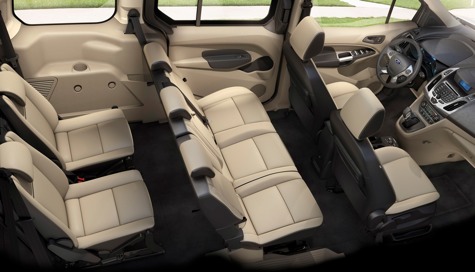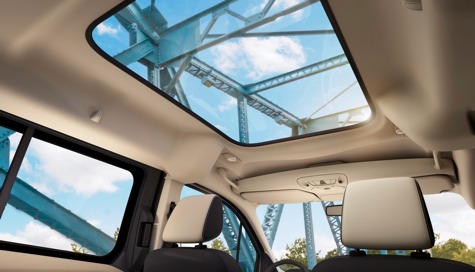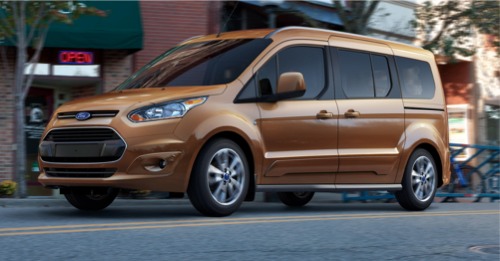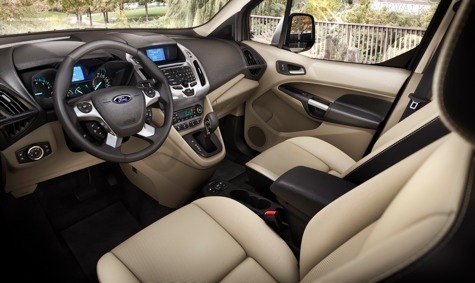Analysis: 2014 Ford Transit Connect Wagon
- November 14, 2012
- Ford, Technology & New Features, What Were They Thinking?
- Posted by Dave Sullivan
- Comments Off on Analysis: 2014 Ford Transit Connect Wagon
What if I told you you could buy a vehicle that had the capability to haul seven people, could hit at least 30 MPG on the highway, and had all of the creature comforts you would want, such as navigation and Bluetooth; would you buy it? What if there was a catch? Would sliding doors break the deal for you? Would riding in a jazzed up cargo van send shivers down your spine?
Well, if you want that kind of capability you’ll have to wait for the 2014 Transit Connect wagon, due out in late 2013. Is it a minivan? Of course. It’s smaller than the E-Series van and smaller than the upcoming Transit full-size van. That makes it mini, right? Ford was quick to compare the Transit Connect wagon to the Toyota Sienna minivan but the Ford is lacking in several areas that are required to get into the shrinking minivan market.
So how does it compare to American-style minivans? The Transit Connect doesn’t have the storage well behind the third row that is basically required to compete as a minivan these days. There will be a dealer installed DVD player available, but if you’ve ever seen some of these dealer hack jobs, they never have the fit and finish or quality you’d get from the factory. The seating is also somewhat clumsy. There are no tricked out disappearing magic acts to be found here with the seats. Yes, the wagon now has rear curtain airbags, something the current Transit Connect wagon lacks.
I was extremely disappointed when Ford decided that Americans weren’t ready for the European Grand C-MAX, I mean, the business case didn’t work. With that nifty disappearing middle seat, awesome looks, and seating for seven, it was a minivan I could get excited about. Alas, it’s not coming.
What Were They Thinking – No Power Sliding Doors?: In recognition that the Transit Connect is a vehicle not first made for the American market, it lacks power sliding side doors and a power liftgate in its feature load. In the hundreds of minivan focus groups AutoPacific has conducted over the decades, power sliders and liftgates have become de rigeur with soccer moms nationwide. These features are not luxuries to a busy and harried mom, they are necessities. Of course they cost more, but over time, they are worth it.
Luckily the Transit Connect wagon will ditch the leaf spring rear axle for a slightly more modern twist beam set up. This should help increase comfort for the driver and passengers but won’t likely match the Nissan Quest or Honda Odyssey’s independent rear suspension for refinement. The wheelbase is HUGE on the seven passenger version, blowing every other minivan away but has a very short rear end that ends up with little space for stuff.
The design is a love it or hate it thing. Pictures I posted on Facebook were marked with disappointment over the design. Americans are slow to embrace European styling on larger vehicles. We can look back at Scion’s boxy vehicles and the Honda Element. Both pushed the design envelope but fulfilled a niche for people looking for quirky vehicles. The Transit Connect wagon has a slightly more difficult role because people will also see them being used as taxis and delivery vehicles. It may not convey the imagine that consumers want, unless they look at their kids and pets as cargo. Even the boxy Ford Flex hasn’t had the sales success that Ford had hoped. Boxy ends up being efficient with the Transit Connect, giving the interior tons of room.
The interior is semi-spartan. It has an instrument panel lifted right out of another Ford and has all of the nice graining, soft materials, and features you’d expect, including heated front seats in the Titanium trim and MyFord Touch. Once you start to look beyond that you notice the cargo van roots. The door panels look more rugged than soft. The headliner has this cardboard-like material that looks like recycled material painted gray. You can always opt for a panoramic glass roof, if you want something a little more jazzed up. The sliding doors don’t have power open and close capability. It doesn’t even have a cinching motor to softly latch them, like the Canadian Mazda5 had. The sweet smell of cargo van DNA starts to come out.
This minivan might be Ford’s answer to the next generation of people movers but Americans have been spoiled with hushed interiors, 42 juice box holders, and BluRay players in their minivans. The Transit Connect wagon doesn’t have all of these goodies. The exterior design is difficult to stomach for sliding door conscious Americans but the true test will be when it goes on sale and if people want a van with great fuel economy, tons of head room, and something that looks like nothing else.
If I were Ford I would have named the wagon the Tourneo Connect. It’ll be difficult for mom’s and dad’s out there to say “yeah, I have a Transit Connect but not the cargo one with no windows…it’s the wagon, I mean minivan thing” because wagon doesn’t exactly have a positive connotation in the U.S. and minivans, well, we know how people feel about those. If you said you had a Ford Tourneo Connect people would probably react differently.
The Transit Connect is a van designed to haul. The wagon is designed to haul people. It’s a mini minivan but not a minivan in the American understanding of what a minivan is and needs we’ve been accustomed to. A utopia of outstanding three-row crossover vehicles without commercial roots stand in the way. It’ll make for a great livery vehicle to sit next to the MKT Town Car but will be a difficult sell as a minivan for American families. Sure, the fuel economy will be great but once it is loaded with seven people and their gear, will merging onto the freeway cause an anxiety attack with the 1.6L four-cylinder EcoBoost? We’ll have to wait until next year to find out.
